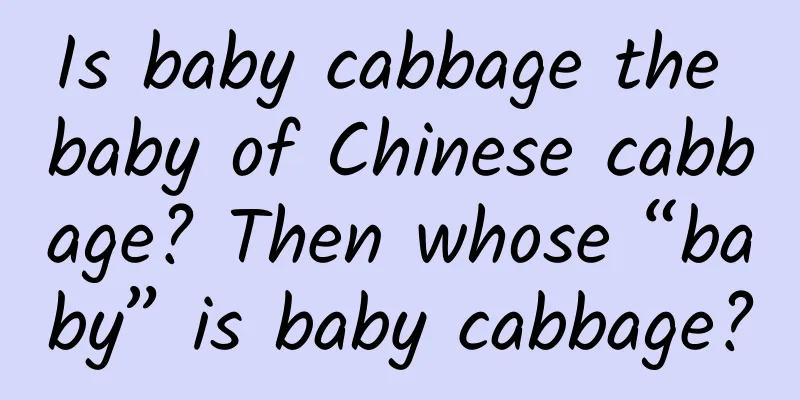Is baby cabbage the baby of Chinese cabbage? Then whose “baby” is baby cabbage?

|
How to distinguish Chinese cabbage, Chinese cabbage and baby cabbage? Is baby cabbage the baby of Chinese cabbage? Then whose baby is baby cabbage? How to distinguish them? The cabbage family is larger than you think! All three belong to the Cruciferae family Chinese cabbage, Chinese cabbage, and baby cabbage are all rich in vitamins and dietary fiber. Their similarities are not only in name and shape, but they are also biologically related. All three belong to the cruciferous family, that is, different species of the same family. Chinese cabbage is a native Chinese vegetable, mostly grown in the north, also known as "cabbage", "cabbage", "yellow cabbage", "rubber cabbage", etc. As a common vegetable with high nutrition and good taste, Chinese cabbage is one of the main winter storage vegetables in the north because of its storage resistance. Xiaobaicai is a specially cultivated non-heading variety (referring to the wrapped shape of the leaves), with more leaves and will not grow into Chinese cabbage. Therefore, Xiaobaicai is really not the young version of Chinese cabbage. Baby cabbage is a small cabbage introduced from Japan and South Korea, specially cultivated and capable of forming a head. It is a semi-cold-resistant vegetable. Baby cabbage is small in size, with a blunt base, and tastes smooth and tender. Therefore, Chinese cabbage, Chinese cabbage, and baby cabbage are all independent individuals. Except that they belong to the same family, no one can replace the other. How to distinguish baby cabbage and cabbage heart? Color: The leaves of baby cabbage are tender yellow, while the heart of Chinese cabbage is yellow with white because it is less exposed to sunlight. Even though many greenhouses prevent Chinese cabbage from being exposed to sunlight to fake the color, the color of Chinese cabbage leaves is different from the natural color of baby cabbage. Appearance: The appearance of baby cabbage is uniform, the width of the head and tail is basically the same, the leaf base is narrow, and the veins are delicate, while the leaves, leaf base and veins of Chinese cabbage are relatively wide, and the thick roots of Chinese cabbage can be seen. Heart: The heart of Chinese cabbage is tight, the leaves are bent inward, severely wrinkled and twisted; the leaves of baby cabbage are straight and flat, and the curled patterns are delicate and beautiful. Size: Baby cabbage is small and feels firm; if you use cabbage heart to impersonate baby cabbage, it will feel loose when you pinch it. Taste: Chinese cabbage has more water, while baby cabbage has thin and tender leaves and tastes more delicious. Which one has higher nutritional value? The vitamin C content of Chinese cabbage is 37.5 mg/100 g, which is about the same as that of oranges. It also has a low oxalic acid content and can be eaten raw. Eating 200 g of Chinese cabbage a day can meet more than 70% of the daily vitamin C requirement of an average adult. Every 100 grams of Chinese cabbage contains 1.2 grams of dietary fiber, and the dietary fiber content of Chinese cabbage stored for the winter will increase over time. Increasing the intake of dietary fiber in the diet can promote gastrointestinal motility, prevent constipation, and reduce the risk of colorectal cancer. Compared with Chinese cabbage, Chinese cabbage has greener leaves and is rich in vitamin C and carotene, which are 1.7 times and 23 times higher than Chinese cabbage, respectively. Chinese cabbage has an even higher content of β-carotene. β-carotene can be converted into vitamin A in the body, which can prevent diseases such as night blindness and dry eyes, and is beneficial to eye health. In addition, the calcium content of Chinese cabbage is also good, at 117 mg/100 g, which is twice that of Chinese cabbage. Although the absorption rate is not as good as milk, it can also contribute to calcium supplementation. Although the vitamin C content of baby cabbage is less than half of that of Chinese cabbage, its potassium content is twice that of Chinese cabbage, and its sodium content is lower than that of Chinese cabbage, making it very suitable for people who need to control blood pressure. Can you tell the difference between Chinese cabbage, Chinese cabbage and baby cabbage? Source: Comprehensive network, if there is any infringement, please contact us to delete. |
<<: #千万IP创科普# Avoid lightning! Air fryers frequently catch fire, you may have been using it wrong
>>: We look like our names? It may be true that people are like their names.
Recommend
Calling on parents to solve the pain of traditional automated testing on the road to entrepreneurship
Testing is a topic that no developer wants to tal...
Help you quickly understand the entire UI design process in 3 minutes
Preface “Design is innovative”; “Design is honest...
Is general anesthesia surgery simply about making people fall asleep?
"Doctor, will this operation hurt?" &qu...
Why do male crabs experience "false pregnancy" after being parasitized?
When it comes to parasites, humans always condemn...
How to build a private domain operation system where old customers bring in new customers?
There is only one core strategy for the growth of...
Is excess body fat obesity? How does a body fat scale know our fat content?
When a person decides to lose weight, the first t...
Why is iPhone the first choice for people traveling abroad? These three points are very important
[[392797]] The network is the most realistic prob...
How to apply for a Baidu promotion account and register a Baidu promotion demo account?
Baidu promotion does not have a simulated account...
People's Daily published an article on new energy vehicle subsidy fraud: The hole must be plugged
Since 2009, the central government has provided s...
The top five marketing trends in 2018, you must know the third one!
In the past 2017, the mobile marketing market has...
Foreign media comment: Native Android is dead
Android M made its debut, and many developers wit...
[Li Jiaoshou] How to conduct consumer research without a large budget?
Consumer Survey Regarding consumer surveys, one o...
Soul-searching question: How can we have a satisfying snowfall?
Recently, our friends in the south have not seen ...
WeChat has launched a new function, the internal testing of the deep cleaning function, which can clean up WeChat storage space with one click
[[429252]] With the continuous update and iterati...
Nissan Motor: Nissan China sales in August 2023 were 64,905 vehicles, a year-on-year decrease of 34.8%
According to recent news, Nissan Motor Company re...









